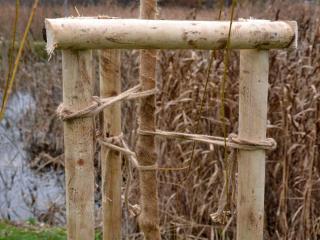

In gardening, some actions might seem insignificant, yet they are crucial for the healthy growth of plants. Staking is one of them. Find out why it’s essential to stake a tree and how to do it with three simple techniques.
→ Also discover:
The principle of staking a tree is simple: it involves placing a support near a newly planted tree to aid its growth.
The first answer that springs to mind is likely, “to make it grow straight.” That’s not wrong, but it’s not the only reason. In fact, it’s not even the most important one.
Indeed, when a tree is freshly planted, it’s exposed to the whims of weather, especially wind. The wind, as it sways the tree like a pendulum, prevents it from rooting properly. So, the role of the stake is to limit, or even stop this from happening, while the tree securely anchors itself in the ground.
Lastly, another reason to stake a tree is to provide support for grafting. In this case, the stake helps to easily hold graft and rootstock together while the graft takes hold.
Not necessarily. Only trees shaped as a long stem, large in size and/or exposed to winds need it. This could include fruit trees and some shrubs. On the other hand, small trees don’t require staking.

Therefore, experts recommend staking a tree when planting it.
At this point, the root system is visible, making it easier to position the stake.
→ Also: make and use root-dip for planting
There are countless methods to stake a tree. However, some are easier and simpler than others, without losing effectiveness.
Despite the differences, there are two common points to all these techniques. Thus, to be effective, each stake must:


Staking a tree on a slope can be a challenge. In this case, just install the stake at an angle of 45 degrees; the direction of inclination following the prevailing wind.

The criteria to take into account when choosing are:
Staking belts have the advantage of meeting these two conditions. As a bonus, when they are well installed in a figure “8”, they also prevent the trunk from rubbing on the stake.
Another solution is to position a pad between the trunk and the stake. The three elements are then held together using a strap with a loop, to adapt to the growth of the trunk.
Very important: whatever the method and material chosen to link the tree and its support, it is essential to monitor growth of the trunk and adjust the tether’s tightness. The risk, if every you forget, is injury to the tree, putting its health in danger.
Of course, these three methods to stake a tree are not the only ones. There are many others like guying, three-stake method, etc. However, they are more laborious to implement, and typically reserved for professionals. Worth mentioning, if you are put off by the unaesthetic nature of the stake, there are ground anchoring systems for an invisible support.
You might be interested in these reads: